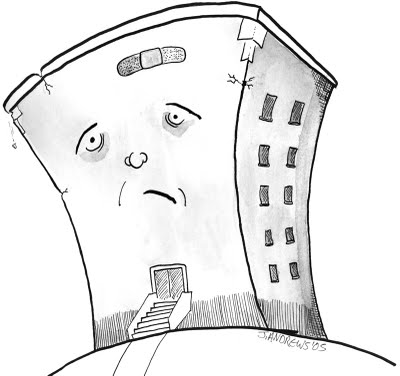by Margaret Wulf, MS
 A healthy learning environment should be every schoolchild’s right. Yet, according to the American Association of School Administrators (AASA), 75% of our school buildings have outlived their useful life. Nearly 5 million children attend substandard schools.
A healthy learning environment should be every schoolchild’s right. Yet, according to the American Association of School Administrators (AASA), 75% of our school buildings have outlived their useful life. Nearly 5 million children attend substandard schools.
An AASA report found that one building in every eight (about 13,200 schools) is inadequate for learning. While our schools’ age and condition should concern us, their indoor air/ environmental quality (IAQ) should concern us even more.
The health effects associated with the IAQ of classrooms have become of increasing concern to parents, educators, and others. Also called Sick Building Syndrome, Tight Building Syndrome, or Building Related Illness, these health effects result in absenteeism and low productivity. They threaten our’ children, faculty and the infrastructure of our education system.
Buildings aren’t “sick,” but their conditions can cause the occupants to become sick. Health problems are usually due to:
- particulates – airborne dirt, dust, lead or asbestos;
- volatile organic compounds – gaseous chemicals, such as formaldehyde, from building materials, carpets, and furniture; or ozone from copiers & other office equipment;
- biologicals – bacteria, mold, and mildew coming from air-handling systems, books, and carpets;
- radio-nucleotides – invisible, odorless, naturally occurring pollutants such as radon.
These pollutants come from surfaces in the buildings, the occupants, and outdoor air. Light, noise, temperature, and humidity can escalate the problems. Continuous exposure to excessive levels of contaminants can cause flu-like symptoms, headaches, nausea, irritated eyes, nose and throat, coughing, wheezing, hypersensitivity, and lethargy.
Often these problems appear one to two hours after the students or staff arrive at school and disappear three to four hours after they leave. The severity of attacks usually increases with subsequent exposure; thus, a slight cold may persist for months.
Remedies to improve IAQ usually focus on chemical pollutants and heating/ventilation/air conditioning (HVAC) systems. But that focus can be misleading. The Environmental Protection Agency and the Occupational Safety and Health Administration report that chemical pollutants are the cause in less than 20% of “sick” buildings. Concentrating on HVAC systems may result in ignoring the most important source of contamination: microorganisms.
Microorganisms, including bacteria, fungi, yeast and algae, thrive on all environmental surfaces (including humans), in the air, and in water associated with normal and catastrophic conditions. Given moisture, nutrients, and acceptable growth conditions, microorganisms can multiply from one organism to more than one billion organisms in just 18 hours!
Unfortunately, the temperature and humidity maintained for the comfort of students and faculty are ideal for growth of many different microorganisms. We cannot escape exposure to microorganisms; therefore, we must control them.
Building-related physical problems caused by microorganisms include odor, staining, defacement, and deterioration of interior surfaces, such as ceilings, walls, carpets, draperies and grouting. Yearly, the resulting corrosion results in billions of dollars worth of damage.
Because of the varied sources of problems caused by sick buildings, evaluating the microorganisms is essential. Using sophisticated equipment, technology and methodology, consultants must be able to evaluate and diagnose the whole picture to define and treat problems without wasting time and money.
Pollutants other than microorganisms can be controlled by removing their source, or by modifying the HVAC system to increase capacity and better filter out the pollutants. These solutions can be expensive and ineffective if microorganisms are the main cause of contamination.
Controlling contamination from microorganisms requires using a broad-spectrum antimicrobial that will adhere to, or become part of, the treated surface and will not disappear by forming a vapor or from conventional cleaning methods. Once applied, it will continue to control the spread of the microbiological contaminants that contact the treated surfaces for weeks or years.
If you suspect your school has sick building syndrome:
- Be proactive; this issue must be addressed immediately.
- Form a committee to work with your school’s health, facilities, and administrative personnel.
- Involve your faculty by educating them about IAQ “red flags” for buildings or humans.
- Enlist the aid of competent outside experts.
- Demand a tracking system that can “catch” or predict IAQ problems.
The health and productivity of our most valuable natural resources – our children and the educators committed to their intellectual growth – are at risk. To learn more, read, Is This Your Child’s World?
